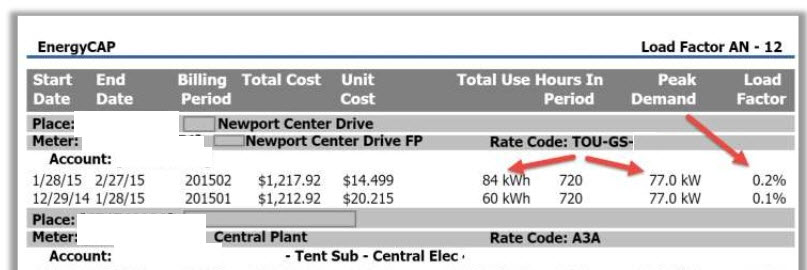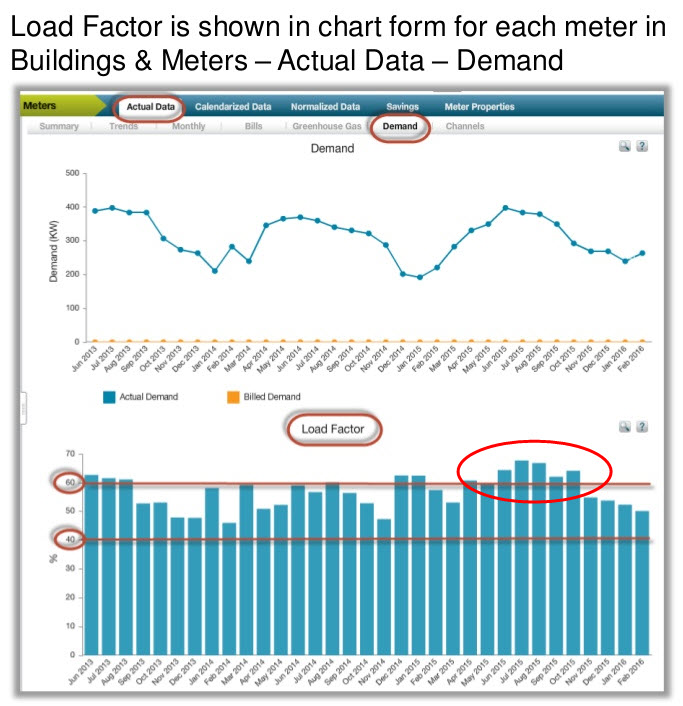 Oh, your aching feet! As an energy manager, your feet might ache because there’s too much load on them. Your buildings may have abnormal load also, and we can measure that using a load factor calculation.
Oh, your aching feet! As an energy manager, your feet might ache because there’s too much load on them. Your buildings may have abnormal load also, and we can measure that using a load factor calculation.
EnergyCAP’s AN12 report will help you spot an abnormal load factor. It’s a tabular report that shows your load factor (from 0 to 100) for each electric bill.
And what exactly IS load factor? Load factor is a simple ratio, a percentage really, that relates demand and consumption. It compares how much electricity you used with how much electricity you could have conceivably used.
Put another way, load factor is Actual KWH Use / Max Theoretical Use. The actual KWH use is the total energy used in the billing period. The maximum theoretical use is determined by multiplying the maximum KW demand for that meter times 24 hours in a day times the total number of days in the billing period.
The load factor value can tell you quite a bit about your meter’s usage profile. Low load factor (maybe 0-30) is an indicator of spiky usage (low usage but with an occasional high peak or peaks), high load factor (maybe 70-100) means steady usage (no or much smaller peaks).
Load factor is a useful calculated value that can help spot issues and opportunities with your electric bills, including data or meter problems, rate change options, and mechanical/electrical system control problems. And knowing what “typical” load factors are for different building types will help you to spot energy problems that may be affecting the load factor.
Changes in load factor for a building that are not seasonal and are not related to common factors like production or occupancy can be a red flag signaling an energy issue that needs attention.
If you run the AN12 for several months, it’s easy to observe trends in your utility bill data to see if your load factor is reasonable. Most nine-to-five types of facilities, including office buildings, are going to be in the 40 to 60 percent range for load factor.
If you have a low load factor, it means your usage is very spikey. Typically, you have low, or no, usage, and then only for short, short periods of time, you have high usage. Typically, low load factor meters are associated with outdoor recreational lighting or some stand-by equipment that may only be in operation occasionally. Low load factor could also be a symptom of a billing error or a meter problem or a data entry issue. So if you see a very low load factor, and it is not a facility for which a low load factor makes sense, then typically you have a problem.
What type of problem? You could have some mechanical equipment like an air conditioner that is over-sized, or located in a climatic condition where it only runs for brief periods. When it’s on, it just blasts out cool air—but only for a very short period of time. Then it immediately turns off. It seldom runs steadily because it is unneeded and/or over-sized. This system is probably inefficient. A more typical low load factor problem is a meter or billing error.
A high load factor scenario would be characterized by a very constant, steady load. Such facilities might include data centers or lighted parking decks, refrigerated warehouses, and similar spaces. Perhaps the lights are on all the time. Or there is a 24-7 type of business operation.
If your load factor for a particular building type is trending higher than you might expect, it can also mean that you’re not setting back building controls during down times. If an office building that is commonly used from 9:00 AM to 5:00 PM has a load factor above 65, that’s probably not a good thing because it suggests that everything’s on all the time. What’s happening at night? What’s happening at weekends? Are things getting turned off?
High load factor is great if the facility warrants it. If it doesn’t, could be a data error, a mechanical problem, or a controls problem.
Utility companies appreciate meters with a high load factor because those meters are predictable, and they represent very steady consumption. The utility is selling their product 24-7. If you have a high load factor facility (80%+), you would be well advised to check with your utility company to see if your vendor offers a discounted high load factor utility rate for that facility. You may be able to save a considerable amount of money.

Occasionally when reviewing your AN12 report, you may discover a bill with a load factor of over 100 percent. You can’t have a load factor of over 100 percent under any kind of normal billing scenario. So if it’s over 100 percent, you have a data problem of some type. You are advised to check the utility bill history associated with that reading.
And here is a meter with a load factor that is very low:

This is the type of situation where you can ask some common questions:
Is this load factor reasonable given the building type and the historical energy trends? Or is there some kind of a data problem somewhere?
In this case, we can see from the data that the peak demand is 77 and total usage for the February bill is only 84 kilowatt-hours. If this is accurate, then we know that 77 of those 84 kilowatt-hours were accumulated in an hour, and for the entire billing period, this meter probably only ran for slightly more than one hour. Is that reasonable? Could that meter be attached to an equipment item that only ran for about an hour the entire month? Perhaps it was some kind of stand-by pump that only runs when there’s a heavy rain because it’s ejecting stormwater from a low-lying area. It might be reasonable. You need to understand your meters well enough to decide if the load factor you are seeing is reasonable or not.
Sometimes, uncovering a load factor issue can return substantial amounts of money for your organization. Let’s see how THAT works:
In EnergyCAP, we display the load factor from the Actual Data tab and the Demand subtab. As mentioned previously, the typical nine-to-five facilities display a load factor between 40 percent and 60 percent. In this example, the load factor is typical for most months, but not all …

As you can see, the circled months are above the 60% threshold for this building type.
Higher load factor tends to indicate more steady loads, but might also indicate lack of night and weekend set back. There may not be a problem, but if you are responsible for monitoring the building energy use, you would want to be certain that setback protocols are being followed. Notice these are predominantly summer months, so air conditioning may be in play.
In summary, load factor can be a valuable tool for assessing building energy performance. So pay attention to those aching feet. They may be a call for help.
This is the fourth installment in our EnergyCAP Health Checkup series. See also:
Scintillating Scotoma
Diplopia
Database Dyspepsia
 Best-in-class portfolio-level energy and utility bill data management and reporting.
Best-in-class portfolio-level energy and utility bill data management and reporting.
 Real-time energy and sustainability analytics for high-performance, net-zero buildings.
Real-time energy and sustainability analytics for high-performance, net-zero buildings.
 A holistic view of financial-grade scope 1, 2, and 3 carbon emissions data across your entire business.
A holistic view of financial-grade scope 1, 2, and 3 carbon emissions data across your entire business.
 Energy and sustainability benchmarking compliance software designed for utilities.
Energy and sustainability benchmarking compliance software designed for utilities.
 Oh, your aching feet! As an energy manager, your feet might ache because there’s too much load on them. Your buildings may have abnormal load also, and we can measure that using a load factor calculation.
Oh, your aching feet! As an energy manager, your feet might ache because there’s too much load on them. Your buildings may have abnormal load also, and we can measure that using a load factor calculation.




